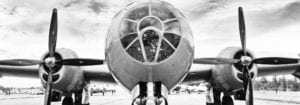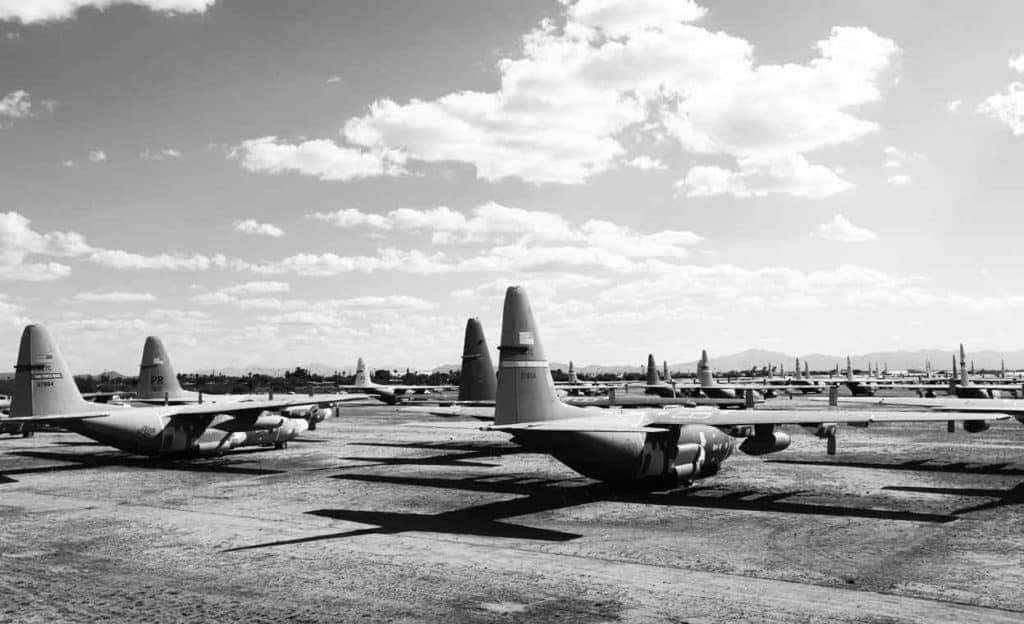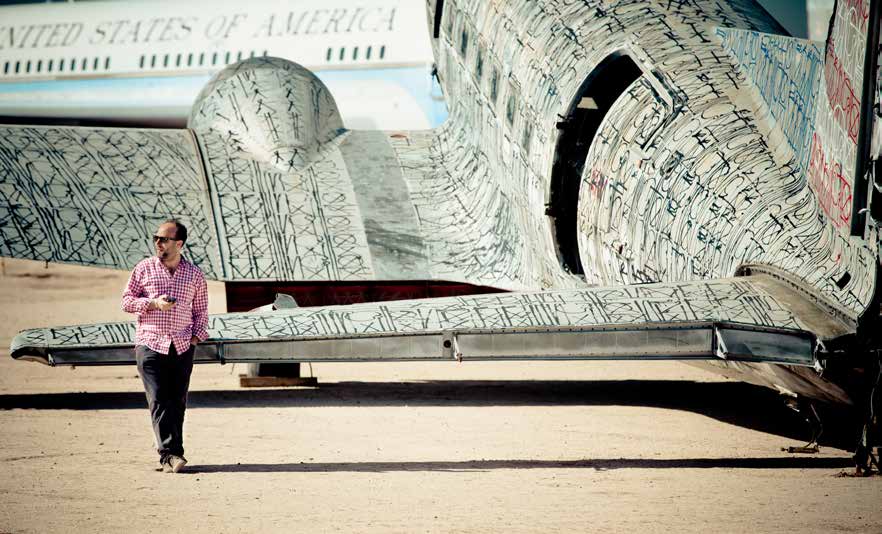Boneyard: The After Flight
Pop cans and glass bottles are recycled. Coffee grounds and eggshells can be composted. Any number of materials can find new life after their original uses are complete, but what about airplanes?
Join Jet Linx for an inside look at a place most never see … an aircraft boneyard.

The next time you fly, consider this: in twenty years, over 30,000 new aircraft will be manufactured. Somewhere between 12,000 and 15,000 aircraft will be removed from service. Some may be disassembled for parts; some may remain largely intact so they could be returned to air service if needed. But where will they go? Where can you store thousands of aircraft safely, with minimum damage from the elements?
The answer is an aircraft boneyard. There are many boneyards across the world, with some of the largest in American deserts. The warm, dry climate allows for outdoor storage with less rust, and the hard-packed alkaline soil is perfect for parking planes without ramps. From above, it looks like the pattern of your son’s pajamas. The rows of airplanes are delicately spaced, grouped by size, a mix of gray and white on a background of dust. Go closer, or approach from the ground, and it starts to get spooky. But don’t let the name fool you: a boneyard is where aircraft go to be reborn.
One of America’s most prominent boneyards is the 309th Aerospace Maintenance and Regeneration Group (AMARG) facility at Davis-Monthan Air Force Base. The base, in Tucson, Ariz., is home to over 3,800 aircraft, ranging from a 1952 Martin EB-57B Canberra to a Boeing F/A-18B “Hornet” used by the Blue Angels. The 309th AMARG has aircraft used by the Marines, Air Force, Coast Guard and NASA, as well as agencies outside the government. Nearby, the Pima Air and Space Museum runs bus tours for visitors and hosts a range of events for the community.
 Founded in 1946 as the 4105 Army Air Base Unit, the 600-member workforce at 309th AMARG is responsible for five mission areas, including aircraft storage and preservation, aircraft disposal, and limited depot-level maintenance. Great care is taken to make sure that the aircraft in boneyards remain unaffected by the heat, dust and sun. An AMARG spokesperson said that each incoming aircraft undergoes an extensive preservation process before storage, including draining, venting, sealing and painting with a strippable, protective paint.
Founded in 1946 as the 4105 Army Air Base Unit, the 600-member workforce at 309th AMARG is responsible for five mission areas, including aircraft storage and preservation, aircraft disposal, and limited depot-level maintenance. Great care is taken to make sure that the aircraft in boneyards remain unaffected by the heat, dust and sun. An AMARG spokesperson said that each incoming aircraft undergoes an extensive preservation process before storage, including draining, venting, sealing and painting with a strippable, protective paint.
Preparation and storage may be the most visible aspect of AMARG’s missions – many of its aircraft can be seen from the surrounding community – but the Boneyard got its name from another of its missions: the reclamation of aircraft parts.
“Workers ‘picked over’ the carcasses of stored aircraft, taking valuable parts and leaving only the bones,” said an AMARG spokesperson. “‘Boneyard’ is a name of pride at 309 AMARG, it recalls a very important mission element of this command. ‘Graveyard’ and junkyard’ are considered derogatory because stored aircraft provide significant value to the U.S. Armed Forces and the American taxpayer by returning usable parts, and ultimately valuable metals to the government.” Approximately ten to fifteen percent of the aircraft stored 2,600-acre facility at the 309th AMARG could be “economically returned to flying service,” the AMARG spokesperson continued. “The remainder is being reclaimed for parts, amounting to approximately $500 million of parts reclaimed annually.” Once an aircraft is declared excess by the owning service, AMARG personnel will prepare the aircraft to be sold as scrap by the Defense Logistics Agency Disposition Services, which returns a portion of the proceeds to the U.S. government.
Aircraft regeneration, or returning stored aircraft to flying service, began at AMARG as early as 1948, and continues to this day. The facility regenerates F-16s for the military’s drone program, along with other aircraft for numerous agencies. In early 2015, a B-52 bomber, nicknamed ‘Ghost Rider,’ was returned to service from the 309th AMARG. The 53-year-old Stratofortress had been in storage at the boneyard for seven years, and had a 70-day resurrection and maintenance process before flying to Barksdale Air Force Base in Shreveport, La.
The military is not the only organization with an interest in long-term aircraft storage, maintenance and sales. Mojave Air & Space Port, in Mojave, Calif., is a boneyard, an airport and home to over 70 transportation industry companies, including heavy rail industrial manufacturing and suborbital vehicle development. The facilities at Mojave have been used to film a number of movie and television projects, from “MythBusters” to “Die Hard 2” and a number of music videos.
End-of-life disassembly, salvaging and recycling are a focus for The Aircraft Fleet Recycling Association (AFRA). The organization was founded in 2006 and now has over 60 members from 18 countries, who have dismantled over 7,000 aircraft from the commercial and military sectors. Its members have 100 years combined experience in aircraft recycling, and the organization works to enhance new technologies and improve environmentally sustainable practices.
“One of the main challenges facing our sector is ensuring that as many players as possible are committed to pursuing best practice when it comes to aircraft dismantling and recycling,” said Martin Fraissignes, Executive Director of AFRA. “As our industry grows and matures AFRA’s goal is to ensure that more and more organizations are both aware of and engaged with our best management practice guide.” This is especially important to AFRA because of the sheer number of airplanes being added to existing fleets, both to replace retiring jets and to expand capabilities.
 When an aircraft reaches the end of that service life, the possibilities for its next adventure are numerous. Entire planes have been turned into works of art, as in Eric Firestone Gallery’s The Bone Yard Project. “I lived in Tucson a long time,” Firestone said. “I’d thought about working with street artists and I’d seen artists who’d used unusual media and painted on transportation, and airplanes struck a chord as something I was very familiar with. I thought that would be a great idea to have the artists paint on airplanes.” Firestone began working on the showing with curator Carlo McCormick in 2011. “We began to find artists to paint on airplanes in boneyards in 2011,” he explained. “At the same time, we wanted something more tangible [to show in New York] since the planes were going to stay in Tucson.” The pair began recruiting artists for Nose Job, which showed at the same time as The Bone Yard Project. For Nose Job, airplane nose cones were repurposed as standalone works of art, adorned with paint designs and even mixed media. “We figured those nose cones would be great for artists to appropriate,” Firestone recalled. “They were sent to artists in the United States and beyond, and we created the exhibition with the nose cones before the airplanes were revealed.”
When an aircraft reaches the end of that service life, the possibilities for its next adventure are numerous. Entire planes have been turned into works of art, as in Eric Firestone Gallery’s The Bone Yard Project. “I lived in Tucson a long time,” Firestone said. “I’d thought about working with street artists and I’d seen artists who’d used unusual media and painted on transportation, and airplanes struck a chord as something I was very familiar with. I thought that would be a great idea to have the artists paint on airplanes.” Firestone began working on the showing with curator Carlo McCormick in 2011. “We began to find artists to paint on airplanes in boneyards in 2011,” he explained. “At the same time, we wanted something more tangible [to show in New York] since the planes were going to stay in Tucson.” The pair began recruiting artists for Nose Job, which showed at the same time as The Bone Yard Project. For Nose Job, airplane nose cones were repurposed as standalone works of art, adorned with paint designs and even mixed media. “We figured those nose cones would be great for artists to appropriate,” Firestone recalled. “They were sent to artists in the United States and beyond, and we created the exhibition with the nose cones before the airplanes were revealed.”
Close to 40 artists were involved in the two exhibitions, which debuted at the Pima Air & Space Museum in Tucson. “A first, we focused only on military salvage, and thinking about appropriating salvage that came from the U.S. government,” Firestone said. “The fact that a lot of that salvage is crushed into beer cans, and it had a life before it went to salvage. We wanted to reimagine a new life for them without them turning into crushed metal. It was my idea of how to have respect for what they were and what they were going to be.”
The medium was inspirational to Firestone through his work: “I just think that the way that the lines of the planes and the beautiful industrial design that comes through the different looks and eras is so important to reflect upon and to see,” he said. “There is a history of planes being customized and artists being involved with companies, like Braniff and Qantas. It’s endless, what can be conceived or designed or imagined with aviation.”
Some aircraft transition into consumer goods for resale, including small parts used in accessories. Australia’s Rushfaster has sold laptop messenger bags with an airplane seatbelt for a shoulder strap. Worn Again, a British retailer, sells with bags, clothes and accessories from different transportation industry lines, including Virgin Atlantic and Eurostar.
Soft goods are only the beginning of consumer-focused aircraft recyclables. Skypak, a German company, creates wine coolers, office file storage and a variety of other pieces from a ubiquitous piece of aircraft furnishings: the drink trolley. “Our La Barrique Collection trolleys and coolers can be moved from room to room, redefining each space they are integrated into. The units are incredibly practical, and can be used from cigar storage to a unique wine case, mini-bar, and so forth,” said Elizabeth von Loewen, International Marketing and Customer Support for Skypak. “Taking rustic, upcycled elements and redesigning the classic airplane trolley is a completely new concept that Skypak introduced to the design world.” Skypak’s website features a wide range of trolleys and trolley accessories, including shelves and drawers.
“The La Barrique collection was created in our partner workshop by talented carpenters who specialize in working with upcycled wood from reclaimed wine and spirits barrels,” said von Loewen. “The workshop is located in the heart of Germany’s wine region, which is where trolleys and coolers are transformed with the aid of careful handwork and the finest recycled wood.”
MotoArt, based in El Segundo, Calif., has been creating furnishings for homes and offices from pieces culled from boneyards. “MotoArt secures airframes all around the world. We have purchased material from Brazil, Thailand and Alaska, to name a few,” said Dave Hall, MotoArt’s cofounder. A MotoArt piece could begin life as a commercial airliner: “Mostly what we find in Mojave is commercial aircraft like Boeing and Airbus,” said Hall. Look for additional stories on life after flight in future issues of SOAR magazine!
Recycling individual parts from an airplane takes great craftsmanship, but it takes a special dedication to repurpose an entire airplane. AirplaneHome.com documents Bruce Campbell’s process of creating a home from a Boeing 727, and his plans to create “Airplane Home V. 2.0” from a Boeing 747. A boat, the Cosmic Muffin, was made from a 1939 Boeing 307 Stratoliner. Originally found in disrepair in 1969, Kenneth London spent four years converting the aircraft into “a sleek and uniquely sensational motor yacht.”
Igor Sikorsky said, “Aeronautics was neither an industry nor a science. It was a miracle.” The next time you fly, consider the aircraft transporting you, and imagine its future possibilities. They are, indeed, miraculous.
Related Stories
Top 25 Travel Destinations for Flying Private: 6-10
Discover the destinations Jet Linx can take our Aircraft Owners and Jet Card Members around the world.
READ MORE
Top 25 Travel Destinations for Flying Private: 1-5
Discover the destinations Jet Linx can take our Aircraft Owners and Jet Card Members around the world.
READ MORE
Jet Linx Aircraft Management: Buying Power
Jet Linx transforms purchasing scale and tech-optimized analysis of pricing, planning and tankering decisions across our nationwide operations into fuel savings our Aircraft Owners.
READ MORE
Related Stories
Top 25 Travel Destinations for Flying Private: 6-10
Discover the destinations Jet Linx can take our Aircraft Owners and Jet Card Members around the world.
READ MORE
Top 25 Travel Destinations for Flying Private: 1-5
Discover the destinations Jet Linx can take our Aircraft Owners and Jet Card Members around the world.
READ MORE
Jet Linx Aircraft Management: Buying Power
Jet Linx transforms purchasing scale and tech-optimized analysis of pricing, planning and tankering decisions across our nationwide operations into fuel savings our Aircraft Owners.
READ MORE



Contact Us